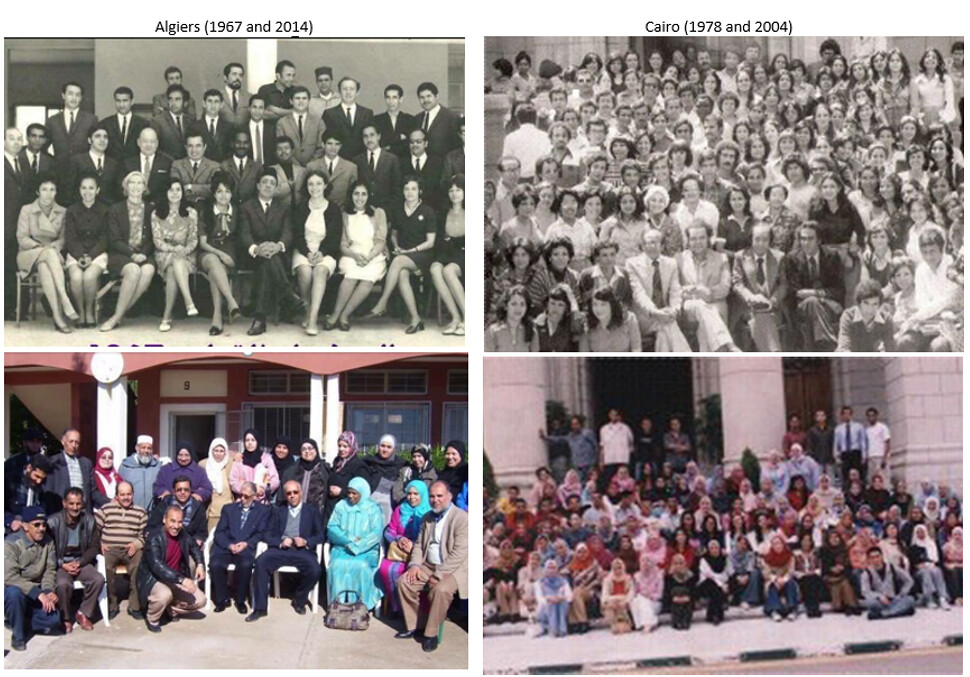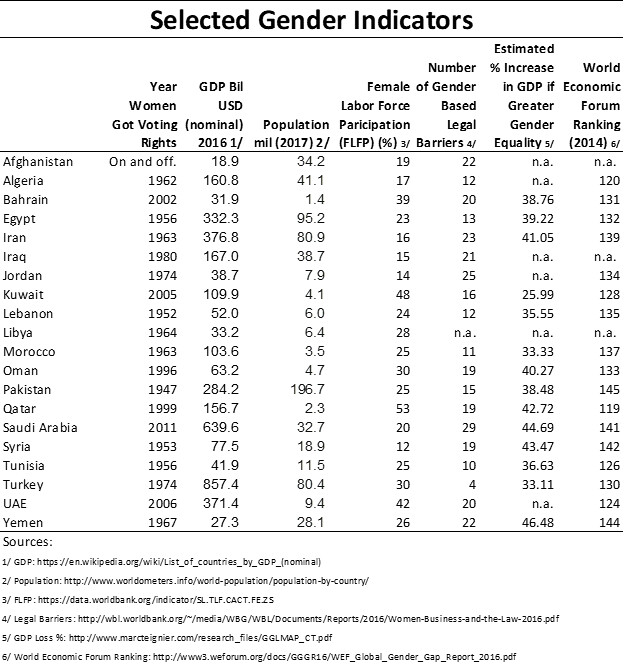Women’s Rights in the Middle East and North Africa

This is a chapter of the forthcoming e-book 'The Future of the Middle East' co-produced by Global Policy and Arab Digest, edited by Hugh Miles and Alastair Newton. Freely available chapters will be serialised here and collected into a final downloadable publication later this month.
In the last years of 19th century, three women would be born who would become trailblazers for their societies and a symbol of their husband’s modernization drive. They were Latife Uşakizâde -- the future wife of Mustapha Kemal Ataturk of Turkey; Soraya Tarzi, the future queen of Afghanistan’s Amanullah Khan, and Nimtaj Ayromlu, the future queen of Iran’s Reza Shah Pahlavi. They became trailblazers not because of their personal achievements – though Latife was a Paris and London trained lawyer, and Soraya spoke several languages and received an honorary degree from Oxford University – but because of what they chose not to wear – the veil.
Dressed in Western fashion, they accompanied their husbands to official ceremonies and to predominantly male public events. They sat, conversed, shook hands with men who were not their mahram (explained later). For tens of centuries, women had not conducted themselves in this manner in Muslim countries. With their actions, they blurred the strict barrier between the male and female domains in their society that had secluded women. They paved the way for their countrywomen to demand more rights and opportunities. And, they succeeded – partially. In 1929, the Afghan constitution enshrined equal rights for women and men. In Turkey women gained the right to vote in 1934. And in Iran, women gained access to universities and became ministers and ambassadors. Over time, however, women would face a backlash and some of these gains would either fully or partially be reversed or are in the process of regressing.

Why was the unveiled appearance of these women so significant? What has been the track record of women’s rights movements in the Middle East and North Africa (MENA) region? And, how do MENA women compare today with their peers elsewhere? This short paper elaborates on the various phases of women’s quest for rights and equality in the MENA region and compares their struggles and gains of in the West.
Birth of women’s movements
Until the 19th century, women across the world enjoyed by and large far fewer rights than men, though the way their inequality manifested itself differed from country to country. With few exceptional periods and few exceptional women, women were generally excluded from the domains of power throughout history, were relegated to be second class citizens, and were subservient to men. Slowly, women began to organize themselves to advocate seriously for greater rights. In Europe, these movements coincided with broader citizens’ demand for voice and participation in government, which led to a series of republican revolts of 1848 and shook European monarchies. Even though the revolts failed, they launched the discourse about citizens’ rights, using neutral terms, though largely still envisioning only men. When decades later constitutions were drafted, women pushed for inclusion in the concept of citizen and the right to vote. In the United States, similar women’s movements took place. Though the US had a constitution and its wording was intended to be genderless and all encompassing, it was in effect written with white male property owners in mind. Other groups had to fight step by step to be included in the definition of citizen. The Seneca Falls Women’s Convention of 1848 is widely referred to as a critical turning point for the women’s movement in North America, which led to the passage of the 19th Amendment in 1920 to give women the right to vote.
These events naturally influenced the developments in the MENA. Additionally, faced with a decaying Ottoman Empire in the second half of the 19th century, thinkers and scholars across MENA began a process of introspection and soul-searching about the roots of their societies’ stagnation while the West had seen considerable technological progress and economic growth. A contributing factor to this self-examination was Charles Darwin’s book On the Origin of Species (1859) that had widely shaken up the intellectual thought worldwide in two ways. It discredited the creation theory, thus undermining religious teachings and establishments which had a stronghold on people’s lives. This was like wind in the sails of secular intellectuals, who had often been at odds with organized religions – certainly the Abrahamic religions. And, secondly, it demonstrated that the natural course of events was that weakness of any kind would ultimately lead to extinction.
Muslim thinkers found a great deal of analogy between Darwin’s naturalistic theories and the plight of their communities. Leading among such intellectuals was the Egyptian Qasim Amin. He saw the condition of the Muslim woman as one of the fundamental causes for backwardness. In his 1899 Tahrir al mara'a (The Liberation of Women), he wrote that women were the backbone of the society and associated the causes for Egyptian underdevelopment to women’s lack of education, to the veiling and to their subservience to men. Joining hands with emerging women’s associations, he began to advocate that elevating the status of women in Muslim societies was a nationalistic necessity and duty. "If Egyptians did not modernize along European lines and if they were 'unable to compete successfully in the struggle for survival they would be eliminated,” he argued. He blamed the oppression of women on traditions rather than Islam and used Quranic texts to claim that women’s rights were supported in Islam.
Muslim vs. Western Women’s Rights and Constraints
But, how did Muslim women fare against the Western woman, when women throughout the world had few rights? Some scholars, like Timur Kuran of Duke University, suggest that Muslim women were in fact relatively better off, and had more economic rights than their peers in the Western Judeo-Christian societies or the Eastern Hindu-Buddhist-Taoist cultures.
Muslim women were entitled to inherit, albeit half of a man’s share. Such rights were irrevocable and spelled out in the Quran. They could not be changed at will. In most Western societies men, and above all first-born males, would inherit the entire estate as the institution of primogeniture dictated. Women inherited only when there were no other direct male heirs.
Muslim women were also entitled to full independence from the husband or any male relative in the management of their wealth and finance. Furthermore, they signed contracts in their own name, and their property and earnings remained entirely theirs, with no need to share it with others if they so wished. The husband was responsible for the care of family, even paying his wife an allowance for being a wife (nafaqa) though in exchange for full obedience, and a quasi-wage (ojrat-ol-mesl) for any household work performed. The wife was not necessarily obligated to allocate her time or labor to the household. In such a case, the husband was required to arrange for someone to do the household work. The husband was to provide in principle for the same style of living as the wife had been used to in her father’s home. i.e. if she came from a well-to-do background, the husband had to make sure that he furnished her a similar lifestyle. By way of a prenuptial agreement, women would also be assured to receive a predetermined divorce settlement. In case the husband would go bankrupt, the nuptial commitment to the wife would be considered the most senior debt, i.e. she would be paid first from the liquidation of the estate before other creditors could be paid. Such economic provisions were intended to prevent that a husband take his wife for granted. They ensured that she be adequately and financially taken care of in the husband’s household, and be sufficiently empowered to care for herself.
The provisions were particularly important considering the institution of polygamy, whereby the husband could take multiple wives, if he could provide for all his wives equally, and could divorce them with ease. This was the flip side of the economic rights that Muslim women enjoyed, which disempowered them. The husband’s unilateral right to divorce and the right to custody of children were ultimately forcing women into submission. Women’s rights to initiate a divorce was considerably constrained or non-existent when the husband provided financially, performed his marital duties, and produced an offspring. When the wife wanted a divorce, she had to relinquish the right to the prenuptial financial settlement – a khol’a divorce. But, even this was not easy because the husband had to give his consent. Hence, while the Muslim woman had enviable economic rights as an individual, the unequal right of divorce within the marriage exposed her to an ever-present risk of repudiation, and the subsequent loss of her children.
For the Western woman, beyond the difficulty to inherit, as discussed above, she would essentially lose any ownership of any property upon marriage; it would become the husband’s property. They, too, had to be obedient to the husband, but in a different context than their Muslim counterparts. What strengthened their bargaining power within the marriage was first that polygamy was not permitted and that both sides had the same rights -- or no rights, to be precise -- to divorce. If divorce became necessary, it was a difficult and lengthy process for both, and had to be based on guilt or breach of marriage (such as adultery). The children would typically stay with the mother. In some denominations, divorced people were excommunicated and not permitted to marry again in the church, which de facto meant that they were shunned in the society.
A far more binding constraint on the Muslim woman to engage in the public sphere has been the concept of ‘mahram.’ A mahram is a relative with whom marriage/sexual relations would be illegal and forbidden (or haram). These were very specific close blood relations such as such as father, grandfather, great-grandfather, son, grandson, great-grandson, uncles, brother, sons of siblings, as well as certain relations by marriage such as mother’s husband, husband’s father, grandfather, husband’s son, grandson. Women were free to mingle with these male relatives and could be unveiled; they could not move around freely and unveiled among men outside this very tight and restricted circle, or without the presence of a mahram. This impeded considerably the interaction of Muslim women in society, in the public sphere, and in circles of power, since they would inevitably be surrounded by men who were likely not their mahram relatives. Though the veil was supposed to facilitate women’s access to the public, over time, women became more and more secluded and a considerable divide developed between women’s quarters – the andaroun – and public spaces. Western women, by contrast, did not face this restriction and could easily engage in the public sphere.
Nationalist Phase
The post-WWI era and the breakup of the Ottoman, the German, the Austro-Hungarian, and the Russian empires, saw the birth of many new nations in Europe, during which constitutions were written and the rights of citizen vis-à-vis the state defined. With an already greater presence of women in the public circles, the natural course for Western women was to gain influence into the halls of power and have their voices heard in decision-making. Therefore, women suffrage became the main goal. By the 1920s, women in a dozen countries around the world had gained the right to vote, beginning with New Zealand, and others were on their way.
As mentioned above, the liberation of women became intertwined with nationalistic goals. Beginning with Turkey in 1934, by the 1950/60s, more and more MENA countries gave women the right to vote, and invested considerably in women’s education. During the first half of the 20th century, most MENA countries also expanded their legal codes, often importing legal concepts and bodies of law from Western countries. However, while women were constitutionally equal to men in the West, most Western laws contained gendered language and resulted in even differential treatment between men and women in he West. In other words, at the time of their introduction into MENA legal codes, these Western laws discriminated against women. As will be explained later, from the 1960s onwards, these laws were adjusted in the West, reformed, and updated to remove any gender-discriminatory language or bias – this process that has not yet fully taken place in MENA. To sum up, the nationalist phase resulted in equality under the constitution and women’s right to vote. But, the adaptation of Western legal codes imported laws largely remain as they were and are often in contradiction with the spirit of the equality under the constitution.
Modernization Phase
The second phase of the women’s emancipation in the MENA came with the ambitious government policies industrialize, done largely done through large-scale state-owned enterprises and enlargement of the public sector. Since men work at nearly equal rates across countries, expanding the workforce can mainly be achieved by attracting women to work outside the home. However, this meant that women had to balance their dual roles as home-makers and workers, and that the work environments had to be respectful and dignified. A host of protective legislation was enacted that ranged from family policies such as maternity leave and childcare facilities, to restriction on the type of work that women could perform, the hours of work, and the surroundings in which they worked. For instance, night work was prohibited as was working in mines or around chemicals. Women’s labor force participation in modern sectors rose considerably during this period. Entire sectors, such as textiles, became only competitive because they depended on female labor. And, foreign investors would flock to countries where they could be assured to find a sufficiently large pool of female workers.
However, while nearly all countries enacted similar types of protective legislation, largely modeled after recommendations by such international organization as the International Labor Organization, women’s labor force participation in MENA did not grow as fast as in other regions. This was largely because women’s labor force participation was still contingent on the husband’s permission, which was frowned upon within prevailing social norms. Since the husband was financially responsible for the family, having the wife work was interpreted as his inability to care for the household. Even poorer families that often needed a second income found it difficult to overcome this tradition. However, from the 1950s to mid-1970s, with the increasing need to industrialize and the enlarge the labor force, MENA moved in parallel with the West by enacting protective legislation to facilitate women’s participation, and this began to pave the way for a percentage of women to enter the non-agricultural labor market.
Neo-Islamization phase
The widening gap between women’s rights in the West and in the MENA countries began in earnest in the late 1970s. A turning point in the global gender agenda was the first United Nations Conference on Women that took place in Mexico City in 1975. It shone the spotlight on a range of laws that, despite the right to vote, still constituted persistent discrimination against women. The Conference led to the Convention on the Elimination of All Forms of Discrimination Against Women (CEDAW) that was adopted by the UN General Assembly in 1979. Over the years, of the 194 UN member nations, 187 countries would ratify CEDAW, though curiously, two countries would still reject to do so ideologically – the US and Iran.
CEDAW caused a great deal of push-back within other Muslim countries. On the one hand, women’s rights groups urged for ratification in parliaments since governments that had voted for the CEDAW adoption by the UN, on the other hand conservative groups raised the specter that CEDAW contradicted the Shari’a. In the end, most Muslim-majority countries ratified CEDAW with so many specified reservations that essentially made the convention meaningless. Slowly, however, women’s rights advocates have been able to justify and push their governments to remove some of the reservations.
In most non-Muslim counties, however, CEDAW offered a platform and a comparative common denominator to guide gender-intelligent legal reforms. It also strengthened the hand of non-governmental organizations (NGOs) who would mobilize the grassroots and generate an impetus for change. Many countries took the opportunity to review old laws in diverse fields, ranging from labor laws, to pension regulations, to social security provision, assess to credit which were redrafted to remove specific legal-based discrimination. The process would frequently entail that a law or regulation would be challenged through the judiciary for contradicting the spirit of constitution – the highest law in the land – that guaranteed all citizens regardless of sex, gender, age, race, religion, etc. equal treatment.
This process of harmonizing the body of laws with the spirit of the constitution has not fully taken place in most MENA countries. As mentioned above, even though a large body of civil codes is based on laws that were imported from the West in early decades of the 20th century, the discriminatory elements are now justified under religious codes. A good example is the nationality law. Throughout the ages, women and men intermarried from different parts of the Ottoman or other Muslim lands. The concept of citizenship was invented in the West. When the law was “imported” into MENA, women in the West could not pass on their nationality to their children. In the meantime, Western countries have removed this restriction; it still exists in MENA legal codes. A Lebanese woman from Beirut married to a Syrian man from Damascus cannot give the Lebanese nationality to her children. Despite its origin, the gender based discrimination is now justified in terms of the Sharia. Christian denominations are not any different. Little by little, though, some countries are finding ways to reform such laws, albeit with great difficulty.
Growing conservatism
Part of the growing disparity between the MENA countries and the rest of the world can be blamed on a growing conservatism since the end-1970s. While the 50s/60s/70s witnessed a secular outlook, the period since has been infused with an Islamic resurgence, in which the question of women’s rights is challenged again. Several factors played a role. On the geopolitical front, the 1979 Revolution in Iran is perhaps the most visible pivot toward conservatism. It reversed most of the reforms of the Pahlavi regime. Another case is the growing conflict within the broader Middle East. The Soviet invasion of Afghanistan in 1979, in which the West fed and used extremist Islamist groups and ideology to fight communism. The continuation of the Israeli-Palestinian conflict fueled radicalism among Arabs. Therefore, from Afghanistan to Morocco, conservative movements gained ground because they provided a useful tool for people to identify against enemies. This was further augmented by the massive amounts of financial support from Wahabi sources that further engrained austere religious thinking that was misogynistic at its core.

A further development that could provide a partial explanation for the conservative tide since the 1980s is a disproportionately faster growth of the traditionally-inclined share of the population vis-à-vis to the modern and progressive segments. What does this mean? Female fertility rate declined from about seven children per woman in 1960 to three children in 2006. While this is good news, it is important to pay attention to the differential fertility rate within the population. Despite lower average fertility rates, religious/traditional families, in which gender roles were more pronounced, still had more children than the “modern” secular family. Larger traditional families are also more likely to discriminate between sons and daughters. In unitary small families the girl child is likely to be treated the same as her brother and both sexes to grow up with gender egalitarian experiences. Fast forward a generation, the differential fertility rate between the traditional and the modern segments of the society lead to conservatives outnumbering the seculars – and this tilts attitudes and politics accordingly.
There are frequently pictures of graduating classes of Arab universities between these two different points of time. They demonstrate perfectly the increasing conservatism of Arab societies. Above are two such examples.
Where do we stand?
The Mexico conference led to subsequent conferences in Copenhagen (1980), Nairobi (1985), and Beijing (1995) to monitor progress. In the West, the legal changes achieved creating a de jure level playing field for women. However, even Western societies still retained hidden sexism and implicit discrimination. Affirmative action for women and for ethnic minorities enabled women to make advances into fields that were previously male-dominated. However, affirmative action was regarded as benefiting women or minorities, and not necessarily the society at large. This perception began to change when in the late 1990s and early 2000s a series of academic articles quantified with robust methods the significant economic returns of gender and race diversity. The studies analyzed the performance of publicly traded Fortune-500 firms over an extended period. Controlling for various characteristics, those that embraced diversity in leadership showed a consistent track record of higher growth in earnings per share and better return on equity in comparison with firms that were led by only white men. Diversity was measured as having at least three women or minorities on board.
These studies were seminal and were replicated repeatedly in the US and in other countries – all with similar results and conclusions. The studies did not posit that by adding just a few token women to company boards earnings could be hiked up. The findings suggested that a company that managed and rewarded its diverse talent pool was likely to be more attuned to market changes, more agile to recognize and adjust to risks, and more likely to better manage its other tangible and intangible assets. Think-alike and uniform boards were less likely to see risks and opportunities.
These studies inspired a range of economic literature that set out to estimate the cost of gender inequality at the family, firm, and economy-wide levels. Universities, corporations, international organizations, and even management consulting firms were among the leading institutions to say that “empowering women is smart economics.” This marked an effective departure from previous approaches in which women’s rights and equality were a goal in themselves. Today, women’s empowerment is not only important on its own but benefits everyone.
The Cost of Gender Inequality for MENA
The main cause of economic losses are the persistent legal barriers and sticky social norms that impede women to access employment, entrepreneurship, promotion, and innovation opportunities. Recent literature by the World Economic Forum, the World Bank, IMF, and various UN agencies demonstrate that the MENA region still has the widest legal disparities between men and women. Not only do these barriers and discriminations place most of the countries of the region at the bottom of any gender-based rankings, they also translate into considerably high gains that these economies could achieve in terms of increase in GDP if they were able to remove the barriers. For instance, women in Egypt face some 20 gender/sex-specific legal barriers in the economic sphere over and above the barriers that men encounter. If Egypt were to remove these gender-based barriers, its GDP is estimated to increase by as much as 39 percent. Similarly, if Iran is found to have 23 legal barriers. If removed, it could boost the GDP by some 41 percent. Similar analysis for the US, for instance, yield a potential increase of 13.7 percent, for Japan, 19.76, and for Germany 14.3 percent. In the long run, the region’s combined GDP could be 37.8 percent larger solely by the removal of gender-based legal barriers. If not addressed, over time, the cumulation of the GDP loss among MENA countries due to gender barriers could lead to a considerable backwardness, as had been envisaged by the 19th century thinkers like Qasim Amin.
Conclusion
There are two main differences between early efforts of the women’s rights movements and today’s approach. The first distinction is that earlier approaches focused on rights-based arguments. This was best articulated at the Beijing Conference in 1995 when then-First Lady Hilary Clinton said that women’s rights are human rights, and human rights are women’s rights. Building on the concept, today’s focus is to quantify the economic cost of gender-based discrimination – the loss of welfare to the entire society – when they fail to realize their potential and are held back. This approach provides new tools, fresh ideas, and innovative methods to create a level playing field for all.
The second difference is the argument that it is not simply enough to educate women and to bring them into the workforce. The real gain from gender-equality can only be achieved when women are involved at all levels of decision-making and leadership because they bring new and different perspectives and insights that are based on their experiences and needs. These insights can lead to better business decisions and better public policies that can ultimately lead to more efficient outcomes for the society. Fortunately, in several MENA countries, women have advanced in government and business position and it seems promising that they will have more opportunities to influence policies and process for more inclusive societies.
MENA countries made considerable progress during the 20th century to strengthen the capability of their female populations through education and healthcare. But, in terms of opportunity and empowerment, the gap between MENA and the West may not have been narrowing in the past 30 years. MENA has not been able to enact the types of legislative changes that are necessary to remove de jure sex-and gender-based barriers. The rest of the world has moved more systematically because the persistence of discrimination ultimately leads to loss of economic potential. This lethargy, and at times slowness and push-back, has been largely due to a rise in conservatism, which is partly due to demographic movements, partly due to rising conflict in the region, and partly to a rise in fundamentalist discourse and finance.
As to the fate of the three women at the beginning of this paper, sadly, their destinies seem to echo the efforts they launched. The reformist king, Amanullah Shah of Afghanistan, was forced to abdicate by conservative forces in 1929. His reforms were largely overturned, then gradually came back, then reversed by the Taliban, and since 2003 slowly reintroduced. Queen Soraya died in exile in 1968. The Queen of Iran, too, left during the 1979 revolution, which ended the secular Pahlavi monarchy. Most of the gender-based reforms of the 50-year rule of the Pahlavis were reversed, except women’s right to vote. The queen died in exile in 1981. Latife, the wife of Ataturk, lived a low-key life and died in obscurity in 1975. Though recent times have seen a revival of conservative attitudes toward women by the Erdogan government, the reforms in Turkey were the most sustainable among the three countries. In the Arab world, there are positive signs, though. Many countries have appointed women ministers with important portfolios to break the glass ceiling. And, recently, women in Saudi Arabia were given the right to drive, to travel with the permission of a mahram, and to participate in elections. Perhaps, with all the ups and downs, forward and backwards, the women in the region are finally turning the corner. Muslim women have come a long way. They are not where they were, they are not where they want and need to be.

Nadereh Chamlou is a former Senior Advisor for the The World Bank.


